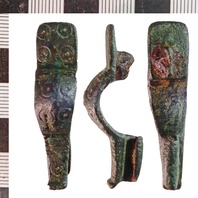
Viking Objects
Copper-Alloy Ansate Brooch (NLM-AED2E2)
The design of these brooches is a variant known as ‘caterpillar’ type which is typically geographically limited to areas bordering the North Sea, though the quantity found in England may indicate local manufacture. The original design of the brooch has a Carolingian origin. Ansate brooches are dated to between the seventh and ninth centuries though the finds at Coppergate in York may extend their popularity into the tenth century. It is possible that this particular example made its way to England prior to Viking incursions but it is equally likely that the Vikings brought this brooch with them as plunder after raiding in Frankia. For more information on Scandinavian jewellery in England check out our blog: Brooches, Pendants and Pins: Scandinavian Dress Accessories in England.
Read More
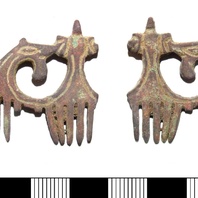
Viking Objects
Comb Pendant (LIN-DD07D2)
The pendant is decorated with two inturned zoomorphic heads executed in Ringerike-style ornament. These comb-shaped pendants are closely paralleled in the area around the Baltic Sea such as northwest Russia, Finland, Latvia and Lithuania, with rare examples from Estonia and Sweden. Pendants were a popular dress accessory in Norway and Sweden and sometimes were worn with beads between a pair of oval brooches. In England, pendants did not have the same popularity and there do not seem to be any contemporary Anglo-Saxon pendants.
Read More
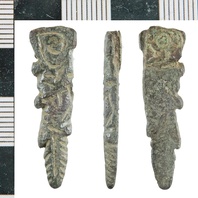
Viking Objects
Strap-End (NLM-42CC0B)
This copper-alloy strap-end is classified as a Thomas Class G type with Viking attributes. The decoration consists of large bordered eye-shaped interlace which may possibly resemble the Urnes style. Strap ends came in various styles and were fairly common throughout the Viking world. They were used to decorate the ends of belts and to stop them getting damaged.
Read More
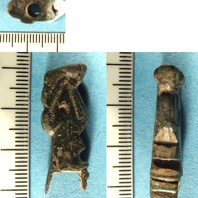
Viking Objects
Prick Spur (LIN-646C93)
Early spurs had a neck that ended in a point, called a prick, riveted to the heel band. This object is a fragment of the prick and is cylindrical in section with a terminal that divides into two arms. There is a hollow shaft above leading into two decorative crescent-shaped arms, one arching over the other. The very top of the object is pierced which suggests that something passed through the object.
Read More
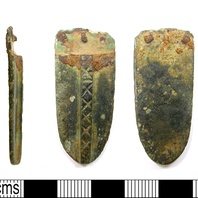
Viking Objects
Copper-Alloy Strap-End (LEIC-07ED69)
This tongue-shaped strap-end, classed as Thomas Class E Type 3, is decorated with a rectangular cross-sectioned vertical ridge running down its centre with incised ‘saltaire’ crosses.
Read More
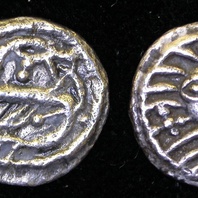
Viking Objects
Continental Sceat (LEIC-901FF1)
This silver Continental sceat is possibly part of Seaby 843 Series X which are considered to be associated with the early trading center at Ribe. It is very likely that they made their way to England by means of Vikings.
Read More
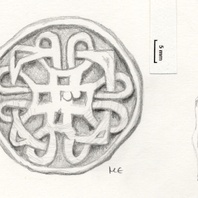
Viking Objects
Lead-Alloy Terslev Brooch (NLM-72D1C7)
This Borre-style brooch has been identified by Jane Kershaw as a Terslev Type V variant. Terslev style, where Scandinavian ring-chain patterns are the main decorative component, is a subcategory of the Borre style and takes its name from the silver hoard discovered in Terslev, Denmark. The decoration comprises a series of ring-knots related to the Borre ring-chain. The Terslev style occurs mainly on brooches and pendants, including both high-quality gold and silver jewellery as well as lower-end base metal items. The cast-base metal jewellery, such as those made of copper alloy, were intended to imitate the higher-end gold and silver jewellery, and often employed techniques such as gilding to achieve this. The Terslev designs that occur in England extend the repertoire by introducing new Scandinavian motifs hereto unrecorded in Scandinavia. For more information on Scandinavian jewellery in England check out our blog: Brooches, Pendants and Pins: Scandinavian Dress Accessories in England.
Read More
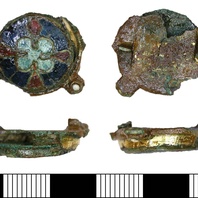
Viking Objects
Enamel Copper-Alloy Brooch (DENO-6C0D22)
This composite cast copper-alloy and enamel gilded brooch displays both Anglo-Scandinavian and Anglo-Saxon characteristics. The decorative enamel centre of the brooch was fabricated using a method known as cloisonné which involves the use of inlaid enamel cells, separated by strips of copper alloy, within an outer ring of copper alloy, all set upon a flat circular disc of copper alloy. The sides of the decorative roundel are surrounded with an upright strip of gilded copper alloy. The design of the enamel centre features a blue-green central quatrefoil, four cells which are shaped like elongated teardrops filled with red enamel giving the appearance of a cross motif, and four larger sub-rectangular cells filled with deep blue enamel. The brooch has been classified as Weetch Type 20. For more information on Scandinavian jewellery in England check out our blog: Brooches, Pendants and Pins: Scandinavian Dress Accessories in England.
Read More
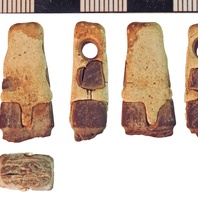
Viking Objects
Whetstone (NLM-7FA566)
Whetstone fragment, possibly made of slate that looks like ‘phyllite’, where the the broken end of the hone has been sheathed in lead, which has held its parts together. This is an unusual example of the repair of a personal hone so it could be continued to be carried and used after its breakage. The hone would originally have been of a tapered bar-shaped form and was sawn to shape. Hones of this size were personal items to be carried and worn at the belt alongside the knife they sharpened. True ‘phyllite’ hones came from Telemark in Norway, and were among the first imported whetstones of the Viking Age. A range of other banded and coloured stones, many found in graves at Birka, were adapted for similar use, and their fine appearance was as important as their usefulness as sharpening stones.
Read More
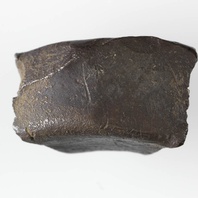
Viking Objects
Arm Ring Hacksilver (CM_1826_2001)
This piece of hacksilver was cut from a square section of a Scandinavian arm ring probably to pay for goods. The Vikings arriving in England had a bullion economy where they paid for goods with silver that was weighed to an amount agreed between the buyer and the seller. Hacksilver and silver ingots are the most common evidence for their bullion economy. It took some time for the Scandinavian settlers to adopt a monetary economy like that of the Anglo-Saxons, and both systems were used simultaneously for a while before they fully adopted the new system. They were familiar with monetary economies but they treated coins as just another form of silver before adoption of a monetary economy.
Read More
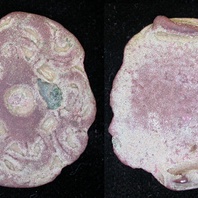
Viking Objects
Disc Brooch (LEIC-604DE5)
This example of an Anglo-Scandinavian copper-alloy disc brooch features a Borre-style knot design surrounded by a concave-sided lozenge motif. It has been classified as East Anglian Series Type I. For more information on Scandinavian jewellery in England check out our blog: Brooches, Pendants and Pins: Scandinavian Dress Accessories in England.
